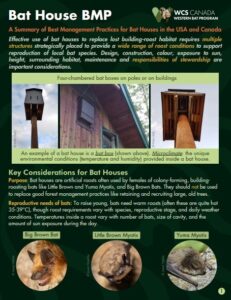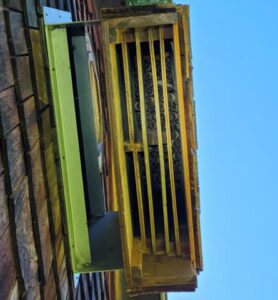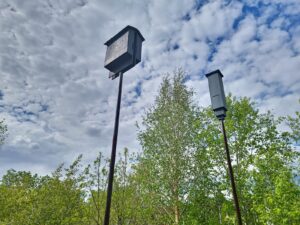
Thinking of a bat house project? Watch our video first.

NEW BROCHURE! "A Summary of Best Management Practices for Bat Houses in the USA and Canada"
The comprehensive "Best Management Practices for the Use of Bat Houses in the US and Canada" has now been summarized in a short brochure. Download your free copy today.
You can also download the FULL Best Management Practices.
Also see our FREE Alberta guide
Common questions regarding bat houses
(click or touch heading to expand)

Bat houses are conceptually similar to bird houses but there are several important differences. These include:
- Bats enter through the bottom of the bat house rather than through a hole in the front
- Bat’s don’t perch like birds do. They instead land on a platform at the bottom of the bat house and use a claw on either thumb to climb up into the chambers
- Bat’s don’t build nests. They stay warm by huddling with other bats.
- Bats can carry their baby from site-to-site, so the number of bats using a bat house can regularly change. One day it might be used and another it is vacant.
It depends on the situation. We generally recommend bat houses be installed prior to excluding bats from buildings (see our page on managing bats in buildings)—they do not always get used, but in some situations, may help reduce the harm to bats from losing access to a building roost. This assumes that the bat houses can be maintained in the area indefinitely.
However, the net effect of bat houses is unknown in most situations. Seven of our species do not often use bat houses, so are either unaffected by bat houses or are harmed by the increased competition. We also do not know whether the bats that use bat houses fare better than those using natural roosting habitat. And bat houses do nothing to provide other resources needed by bats, such as drinking water and foraging habitat, which may be more limiting in many environments.
- Some bat house designs are prone to overheating—it is important to use a design less prone to extreme heat and make sure that multiple bat houses are installed, with options in both sunny and shaded locations. It is important to avoid the scenario where bats become reliant on bat houses and then experience high mortality because of overheating or disturbance.
- Bats are long-lived, potentially living 40 or more years. Roosting colonies can last decades. You want to make sure that once bats move into an area they will be able to find suitable roosting habitat for decades to come. If you are not going to stay on a property long-term then consider what will happen to the bat house once you move.
- Bats poop A LOT! Make sure the bat house is placed in a location where the mess won’t create a problem. You don’t want move a bat house once it becomes successful.

The two-chambered rocket box (image, right) is also conceptually a good design for bats. They are able to move around a central post, which should allow them to find the best available temperature. If it’s too hot, then can simply move to the side away from the sun. However, in Alberta rocket boxes tend to have lower uptake than the multi-chambered bat house. Rocket-boxes are also more difficult to build. Designs can be found in the Bat House Builders Handbook.
We DO NOT recommend single-chambered bat houses because they are prone to extreme overheating, especially if installed in full sun (they can exceed 60°C!). If you already have one, then they can still be installed in a shaded location. Small multi-chambered designs (i.e., those that are not much bigger than bird houses) are also not suitable because they are too small to stay warm and cannot support typical bat colony sizes. Most bat houses sold in hardware stores and greenhouses are novelty items and best avoided.
We recommend you read the Alberta Bat House Guidelines before building or installing bat houses in Alberta.
Bats are not birds. They do not build a nest and stay in one place until their offspring fly. Instead, they often have many roosting locations and move around from night-to-night. We do not know exactly why they do this, but it does give them the opportunity to find a roost that best meets their needs on any particular day. The best approach to help bats is to install multiple bat houses in an area (i.e., within about 100m). At least one bat house should be designed to stay cool (e.g., north aspect and/or stained a light colour) and one or more others should be designed to stay warm (e.g., in a relatively sunny location and/or stained a darker colour). We recommend installing 3 or more (perhaps in collaboration with your neighbour). For most of the year bats will prefer the warm, sunny location, but during heat waves it’s important they are able to get out of the sun. Bats may also prefer cool locations if they want to use torpor (a controlled lowering of their body temperature) to save energy.
Information on building bat houses in Alberta can be found in the Alberta Bat House Guidelines and, more recently, the Best Management Practices for the Use of Bat Houses in U.S. and Canada.
Yes, bats need more than bat houses to survive! Bats, like all animals, require access to food (insects), water and shelter. They also need commuting habitat that links these different habitat components (they often follow the edges of forest, rows of trees, or along rivers).
Bat houses provide alternative roosting habitat for some bat species. In Alberta, these species are typically Little Brown Myotis and Big Brown Bats—the same species that are most likely to roost in buildings. In a city like Calgary or Edmonton there are lots of old buildings, so roosting habitat is probably not much of a constraint for these bats (although bats sometimes come in conflict with people when they use buildings). Possibly food is more constraining to bats in cities because natural wetlands are often drained and vegetation is often removed and highly manicured. In these areas, ensuring wetlands and riparian areas (vegetation adjacent to rivers) is healthy may do more to help bats than bat houses.
